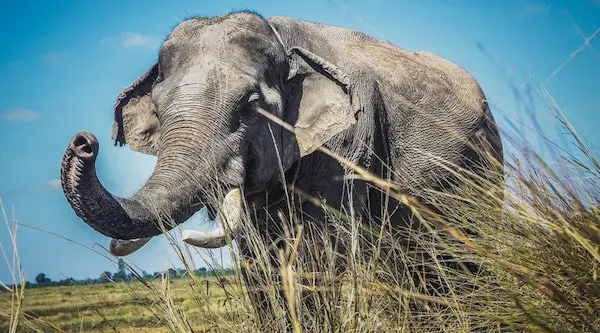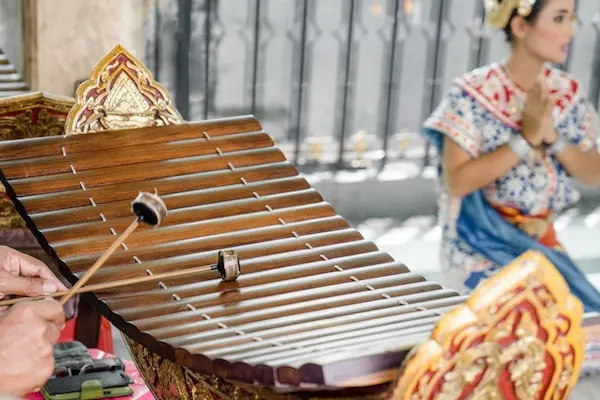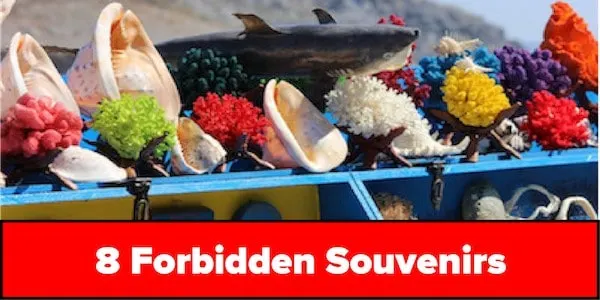Those who travel usually want to bring home a few nice souvenirs from their holidays to give to their loved ones or simply to keep the journey in their best memories. Souvenirs are available in abundance at most holiday destinations, and so the traveller is always spoilt for choice: Which souvenir should it be?
While we can’t help you choose the perfect souvenir, we can certainly help you not to put your foot in it and select forbidden souvenirs! Wait a minute…FORBIDDEN souvenirs? Yes. This refers to souvenirs that either may not be imported at all (also not for personal use!) or only with special import documents. Such souvenirs, which are protected according to the Washington Convention on International Trade in Endangered Species of Wild Fauna and Flora (WA), exist in all sorts of different forms and are primarily concerned with protected animals and plants and all products made from them.
If you are thinking of bringing one of the following 8 souvenirs, which we will present to you in a minute, then you should strongly reconsider your choice because the import of those 8 souvenirs is illegal and could cost you dearly and in the worst case could even result in imprisonment.
All products from elephants and rhinos

Elephants and rhinoceroses belong to the strictly protected types according to the Washington Convention on International Trade in Endangered Species of Wild Fauna and Flora (CITES). The African and the Asian elephant are both listed in Appendix A of the WA, which contains animals and plants that are highly endangered by trade.
Elephants and rhinos belong to the strictly protected species according to CITES. However, this does not only apply to the animal itself, but also to all products made from components of these two animals, such as hides, ivory or horn.
So if you are offered ivory, elephant hair or rhinoceros jewellery or other products with ingredients from these two animals at markets, you should refrain from buying them in your own interest. This is an important contribution to the protection of these species because the illegal trade lives on the demand for the products and if they are no longer bought, then no more animals have to die for them.
Products processed with ivory are mainly found in the jewellery sector. However, there are also numerous other products that can contain ivory. For example, the ivory of the Asian elephant was often used for piano keyboards. But ivory can also be found in musical instruments such as the transverse flute.
With many products, it is unfortunately very difficult to recognize whether they are products from protected species according to CITES. Jewellery made of elephant hair, for example, can easily be misinterpreted as plastic or leather. Therefore, the rule applies here: In case of doubt, let it stand.
The situation around ivory has drastically worsened in the last two decades. According to the Tagesspiegel, a German daily newspaper, Europe is unfortunately also becoming more and more the hub of illegal trade. Besides, every year about 20-30 thousand elephants are poached because of their tusks. Despite generally stricter regulations regarding the trade of ivory, even stricter regulations would have to be established in the future to protect the animals and effectively prevent the trade with ivory.
Royal wool “Shatoosh” from the Tibetan antelope

Royal wool from the Tibetan antelope, which is processed into luxurious scarves among other things, must not be imported as a souvenir under any circumstances. The trade with Shatoosh is strictly forbidden and who does not keep to it, must count on a juicy fine. The wool hair of the Tibetan antelope, which is also called Chiru (Pantholops hodgsonii), is particularly coveted because it is the finest of all animal hair. The illegal scarves, which are made from the wool hair of the Tibetan antelope, are partly sold for horrendous sums. Shatoosh scarves, which cost the buyer several thousand euros, are often confiscated at customs.
Shatoosh wool, also known as “royal wool” in German-speaking countries, should not be touched at all. Because the wool, which is won from the endangered Tibetan antelope, may neither be processed, bought nor sold. Import and export are, therefore, strictly forbidden.
The beautiful Tibetan antelopes occur in the steppes of the Tibetan high plateau. One finds the animals usually in heights from 3200 meters to approximately 5,500 meters above sea level.
While about 100 years ago there were still about one million Tibetan antelopes, the population has meanwhile shrunk to a frightening 75,000 individuals. Meanwhile, according to the WWF, the situation is looking somewhat better again, as the population is now estimated at around 100,000 to 150,000 individuals.
Turtle shell of sea turtles
Products made of tortoiseshell from sea turtles are taboo. The import into the EU is illegal, and so you better keep your hands off it. Products made from sea turtle shell include jewellery, bowls, glasses, hair clips and combs.
The tortoiseshell is obtained from three different species of sea turtles: The Green Sea Turtle, The Loggerhead Turtle and the Hawksbill Turtle.
The tortoise shell is obtained from the flat horn scales of the back shield of the sea turtles. The Green Sea turtle, as well as the Green Sea turtle and the Loggerhead turtle, are all to be found in Appendix I of the CITES and therefore belong to the particularly endangered species for which very strict protective measures apply.
Instruments and accessories made of Brazilian Rosewood

Instruments like this marimba, which contain elements of Brazilian Rosewood (Dalbergia Nigra), in German often referred to as Rio palisander, are subject to strict import and export regulations. This precious wood is often found in older guitars, such as Fender or Martin guitars. For the import and export corresponding documents are needed. This is especially true if the instruments were purchased after 1992 when Dalbergia Nigra was placed under species protection by the Washington Convention on International Trade in Endangered Species of Wild Fauna and Flora.
Brazilian Rosewood, also called Dalbergia nigra, is a tree species from the genus Dalbergia. However, the name Brazilian Rosewood is also used for the corresponding wood species.
Brazilian Rosewood, who would have though it, grows in Brazil. The occurrence of the tree species was drastically decimated over time by long-term logging, and so the rosewood was included in the Washington Convention on International Trade in Endangered Species of Wild Fauna and Flora in 1992. There one finds Dalbergia nigra in Appendix I, thus with the animals and plants, for which the highest protection level applies.
However, the possession of musical instruments with components made of Brazilian Rosewood is not illegal per se. Nonetheless, there are various things to consider here. So if you want to import such instruments from abroad, let’s say by air, then you must inform yourself about the situation and in any case have the corresponding certificates and papers in accordance with the CITES Convention. This is particularly true if you acquired the dubious instrument after 1992 when the precious wood was included in Appendix I of the Washington Convention on International Trade in Endangered Species of Wild Fauna and Flora.
Please find the most important information in this PDF on the subject of “Trade in Dalbergia Nigra and the European Union”
No “Tiger Selfies”

Want to pose with a tiger and make a selfie for Instagram? No. Just don’t. Because also photos with allegedly tamed wild animals are forbidden.
A photo can also be your undoing. For example, if this photo is a selfie on which you can be seen together with an allegedly tamed wild animal. Such photos may not be imported.
Sadly, there are now more and more places where travellers can pose for photos with wild animals. Of course, such snapshots bring in a lot of Likes, but please think of the poor animals.
Because where animals are used for such purposes, illegal trade needs to be suspected. And what is more, the money that you spend to get those kinds of selfies probably supports the Wild Animal Mafia or another extremely questionable institution.
Also, such photos are also completely unacceptable as far as animal welfare is concerned, as the animals are drugged with sedatives for these purposes.
Beach souvenirs like mussels, corals or queen conchs

As we have seen earlier, souvenirs like royal wool from the Tibetan Antelope are under species protection, and the trade with them is strictly forbidden. But who would have thought that one also has to pay attention during beach holidays which gifts of the sea one collects; many probably would not have counted on that. This large queen conch (see picture), for example, is also subject to species protection. However, for personal use, up to three housings per person may be introduced into the EU without documentation.
The queen conch is under species protection. It is listed in Appendix II of the Washington Convention on International Trade in Endangered Species of Wild Fauna and Flora. However, travellers are lucky here: For personal use, up to three housings of the Great Fencing Snail may be brought home as a souvenir from a holiday without having to present the corresponding documents (CITES certificate).
For example, mussels and snails such as all giant mussels may not be imported without further ado. However, there is one exception for the Queen Conch as well as for the Giant Clams, both of which are species protected in Appendix B of the WA: For personal use, you may take home up to three housings of the Queen Conch and up to three specimens of the Giant Clams (not alive, of course) without corresponding documents in your personal luggage. But be careful: personal use is to be interpreted in the narrower sense. If you want to give away the queen conch housings as a present, for example, this is no longer personal use.
Another classic is corals. The import of corals of any kind is forbidden unless you have a special permit for it. This also applies to corals found on the beach. So you better do without corals as a travel souvenir.
Seahorses are also under species protection. However, according to EU Customs, each individual is allowed to import up to four dead specimens of seahorses without any documentation.
What about starfish? Dead starfish, such as those that you have found during your daily walk on the beach, should not cause any problems with the import, as they are not under species protection.
Cacti of any kind and shape
Cacti are also on the blacklist. You can’t just take these cute things home. Also not for personal use. An import or export is only possible with special permission (special import/export documents are required). Within the EU you can transport cacti however problem-free. Make sure, however, that you carry a purchase receipt with you.
Practically all cacti are subject to species protection and therefore may not be imported into the EU without a corresponding CITES certificate. Introducing a cactus for personal use without corresponding papers is therefore forbidden.
Snake liquor

Snake liquor (also called snake wine), as strange as it may seem to Westerners, is widespread in Asia. In that region of the world, one finds the snake drink – which usually consists of poisonous snakes marinated in alcohol, such as cobras – in Vietnam, Laos and also in the Middle Kingdom. If you would like to taste it, you better do that during your holidays rather than trying to bring some snake wine home as a souvenir, because the import of snake liquor is strictly forbidden.
Snake schnapps is not necessarily the souvenir that first comes to mind when you think of souvenirs in general. At least not if you don’t come from Asia yourself. But in Asia snake liquor is relatively widespread. And so it could, of course, be that one could have the great idea to stow a bottle of snake liquor in his luggage as a souvenir.
Well, this is not exactly a good idea, because the import of snake schnapps is forbidden. And let’s be honest: Snake liquors are not that discreet after all, because they are literally liquors that come with a snake in them. But you have probably already taken that from the picture.
Paradoxically, poisonous snakes are mostly used for snake schnapps. But there is no need to be afraid of the snake venom because the poison is rendered harmless by the alcohol.
However, if one is allowed to believe the press, then it can happen that the contents of the bottle are still alive at the time of purchase. Thus, the Global Times 2013 reported that a cobra apparently survived three months in a snake liquor bottle and even bit a woman…argh…but now enough horror stories for today!

Hey guys! It’s me, Marcel. I am the proud owner of carry-on-baggage.com. I am dealing with hand luggage related issues on a daily basis and I own several websites in this niche. Travelling is one of my biggest passions in life and I, therefore, happen to know a thing or two about hand luggage. I hope you all have a safe trip! Take care and thanks for the support. I really appreciate it.


